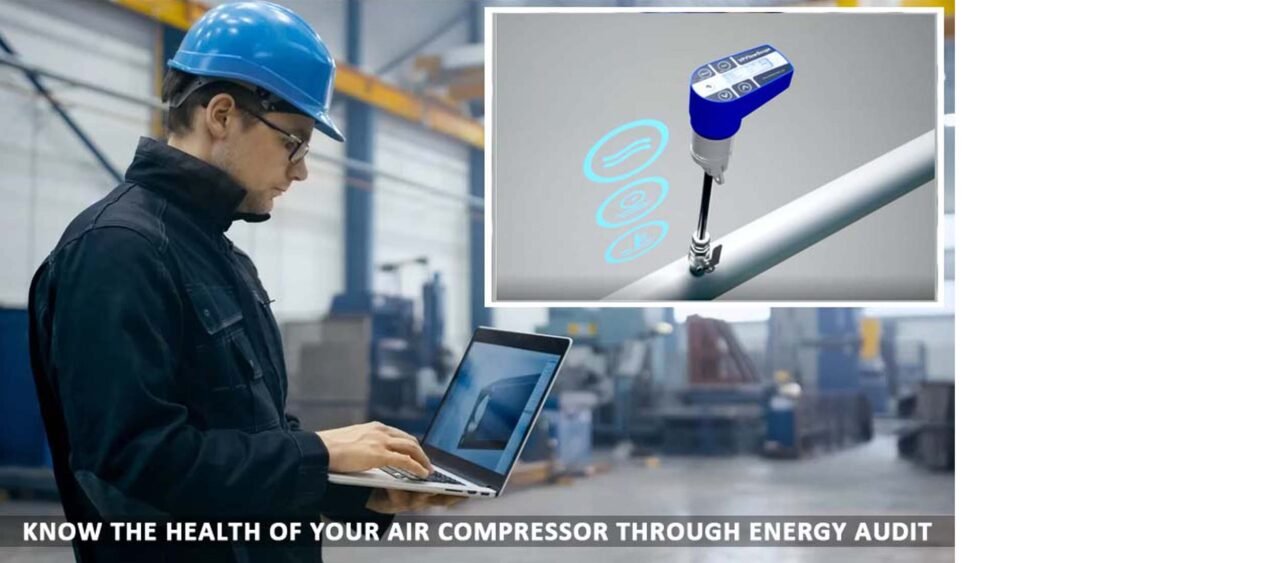
Measuring Performance of Installed Air Compressors
It might be difficult to gauge an air compressor’s Free Air Delivery (FAD). This task can be completed with simple arithmetic and an appropriate flow meter.
By sucking in ambient air, pressurizing or compressing it, and then releasing it into the compressed air network, an air compressor ultimately produces compressed air. The power rating of an air compressor and the FAD specifications listed by the manufacturer when it was first built serve to characterize its power. An on-site measurement, however, can be quite helpful over time. The answers to a few straightforward questions ultimately illustrate how an air compressor operates:
- What percentage of electricity does my air compressor use?
- What percentage of electricity does my air compressor use?
- What pressure profile do I have?
You might want to check your air compressor’s measurements on your own to get the answers to these questions. There are typically two categories of performance measurements:
- Temporary performance evaluations, carried out as part of system evaluations or prior to purchasing a new air compressor.
- Permanent performance measurement is used to continuously monitor performance in order to prompt servicing or overhauls when necessary.
How is FAD Defined?
Volume per time unit is the unit used to measure flow. However, air is easily compressed, and its volume varies with temperature. The humidity (water vapor) in the air that an air compressor draws in varies with altitude, temperature, and weather patterns, as does the air density (air per m3).
“Actual volume flow rate of a compressor is the actual volume of gas, compressed and supplied at the standard discharge point, referred to conditions of total temperature, total pressure, and composition prevailing at the standard inlet point,” reads clause 3.4.1 of ISO 1217.
According to the circumstances of the free air at the compressor inlet, this is the actual amount of air that the air compressor provided. The amount of free air that is actually delivered by the air compressor at its compressed air exit is known as FAD.
Volumetric flow units like m3/min and l/s are used in FAD. The flow meters permitted by ISO 1217 first calculate an air mass flow, which is then transformed to an intake volume flow rate based on an estimate of the air density at the air compressor’s intake. However, for convenience, and assuming that the actual conditions are within a permitted tolerance, ISO 1217 recommends the following requirements:
- 1 absolute bar equals pressure.
- 20 °C for the temperature
- 0% relative humidity
What Affects the Efficiency of an Air Compressor?
The intake humidity and the motor’s speed in relation to its rated speed are then corrected.

The effectiveness of air compressors is influenced by a few factors.
Manufacturers of air compressors evaluate the efficiency of their machines using international standards (such as ISO 5389 for centrifugal air compressors) and provide the findings in their data sheets. These measurements, however, are carried out under factory conditions rather than actual on-site circumstances.
Additionally, an overhaul may be necessary if the air compressor’s performance deteriorates with time. An on-site measurement is advised to evaluate an air compressor’s performance. Additionally, real-time monitoring is crucial for estimating the performance of air compressors in real-time.
.Methods for Measuring the Discharge Flow & Calculate the FAD.
Air, water, oil, and particulates are all included in the air compressor’s discharge flow. Some measurement techniques are ineffective because they can’t handle the flow of water and oil. Others are not appropriate because they result in a pressure decrease, which wastes energy and money.

The requirements for a flow meter used at the compressor discharge include:
- unaffected by particles
- resistant to drops of water and oil
- being able to withstand high speeds and temperatures of up to 150 degrees Celsius
- Minimum pressure drop is preferable than none at all.
- a flow meter with an insertion type that works for short-term measurements
The performance of an air compressor should be measured at the outlet, according to the user. What comes out matters more than what goes in.
A portable flow meter’s discharge flow measurement must be converted into FAD together with data of the operational temperature and pressure.
The air compressor uses the computed FAD.
How to Measure Power
When calculating full-load specific power (m3/min/kW) or estimating flow (m3/min) of an air compressor, amperes alone are frequently assumed to be a valid measurement of kilowatts (kW). This is untrue.
Amperes and voltages must be measured at each of the air compressors’ three phases using a power meter that can also calculate the power factor in order to make an accurate power measurement. Here is the power equation:
kW = (A x V x 1.732 x PF) / 1000
- Kilowatts are the input.
- Motor current equals A (amperes)
- lines voltage
- Power factor (PF)
Conclusion
It’s crucial to measure the performance of air compressors. You will get even more advantages if the compressed-air system is continuously monitored.
Predictive maintenance is essential to ensure that parts are repaired before they break down. Additionally, monitor your energy usage to be sure your investment will pay off quickly. These elements, along with recurring leak inspections, will enable you to take advantage of a healthy and effective compressed-air system.

As PNEUMSYS is regularly executing audit services for reciprocating and screw compressors both for lubricated and non lubricated compressors,
A sample audit report of an actual project is available for download below.
The privacy and confidentiality of the client has been obscured to protect their identity for obvious reasons.

